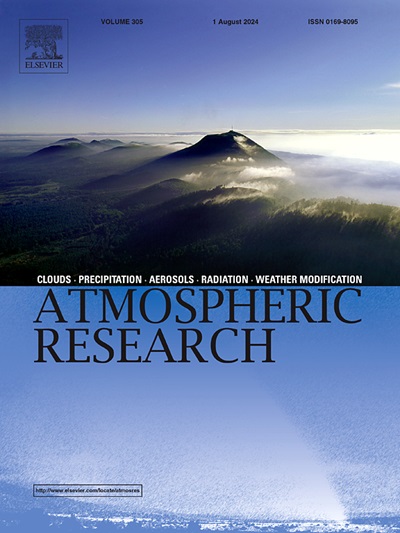北热带大西洋海温对季风前喜马拉雅南坡0°C等温线高程的锁相效应
IF 4.5
2区 地球科学
Q1 METEOROLOGY & ATMOSPHERIC SCIENCES
引用次数: 0
摘要
本研究利用HadISST和ERA5再分析资料,研究了季风前喜马拉雅南坡0°C等温线高程的趋势剔除变率及其主要控制因素。研究表明,去除0°C等温线高程上升趋势后,北热带大西洋海表温度对0°C等温线高程84.5°E附近节点的异常跷跷板型存在锁相效应。当NTAO海温异常较正常温度偏暖时,在非洲西部-青藏高原东南部以相同的距平中心从对流层下层到上层被强迫出波列型。与这种波列模式相关的异常温度偶极子是季风前喜马拉雅山脉西(东)南坡0°C等温线海拔上升(下降)的直接原因。当NTAO海温异常偏冷时,则相反。这种NTAO海温与趋势去除等温线高度之间的显著锁相相关性,从去年秋天一直持续到现在的季风前季节,将有助于阐明和减轻冰川相关灾害带来的风险,如喜马拉雅南部的冰湖爆发洪水和雪崩。本文章由计算机程序翻译,如有差异,请以英文原文为准。
The phase-locked effect of north tropical Atlantic SST on the trend-removed 0 °C isotherm elevation along the southern slopes of the Himalayas in pre-monsoon season
This study uses HadISST and ERA5 reanalysis data to investigate the trend-removed variability of the 0 °C isotherm elevation, and the main controls on this variability, along the southern slopes of the Himalayas in pre-monsoon season. Here we show that the sea surface temperature (SST) in the north tropical Atlantic Ocean (NTAO) exerts a phase-locked effect on the anomalous seesaw pattern in the 0 °C isotherm elevation with a node around 84.5°E, after the upward trend in the 0 °C isotherm elevation is removed. When the NTAO SST anomalies are warmer than normal, wave-train-like patterns are forced out over western Africa–southeastern Tibetan Plateau with the same anomalous centers from the lower to upper troposphere. An anomalous temperature dipole associated with this wave-train-like pattern is the direct cause of the rise (fall) in the 0 °C isotherm elevation along the southern slopes of the western (eastern) Himalayas in pre-monsoon season. When the NTAO SST anomalies are colder than normal, the opposite situation develops. This significant phase-locked correlation between NTAO SST and trend-removed isotherm elevation, which persists from the previous autumn to the current pre-monsoon season, will help to both elucidate and mitigate the risks posed by glacier-related hazards such as glacial lake outburst floods and avalanches over the southern Himalayas.
求助全文
通过发布文献求助,成功后即可免费获取论文全文。
去求助
来源期刊

Atmospheric Research
地学-气象与大气科学
CiteScore
9.40
自引率
10.90%
发文量
460
审稿时长
47 days
期刊介绍:
The journal publishes scientific papers (research papers, review articles, letters and notes) dealing with the part of the atmosphere where meteorological events occur. Attention is given to all processes extending from the earth surface to the tropopause, but special emphasis continues to be devoted to the physics of clouds, mesoscale meteorology and air pollution, i.e. atmospheric aerosols; microphysical processes; cloud dynamics and thermodynamics; numerical simulation, climatology, climate change and weather modification.
 求助内容:
求助内容: 应助结果提醒方式:
应助结果提醒方式:


